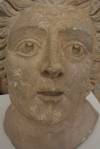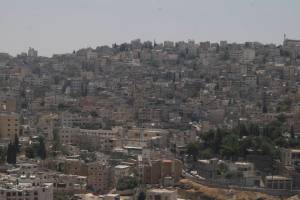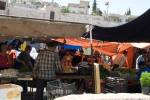Amman again
So, I’m back from my little sojourn outside of Amman, and am now a little better prepared to tell you a little about Amman itself, and share some of the adventures I had, outside Amman. I’m expecting, tho’, that there’ll be more pictures than text, after this post, which sets the stage — I used up 3 2G memorycards; and completely depleted one camera battery. That being said, I should also add that my photographic skills emphasize quantity over quality at the moment (digital age) — so I’ll just show you what I consider to be some of the “better” pix, prior to photoshopping, which I’m saving to-do till I get home.
 Amman is not the easiest city to get around in, for Westerners — especially for Western women. It’s not that it’s impossible, or unfriendly, exactly; certainly when I think about what the experience might be like if I were Jordanian, visiting Los Angeles, it might be that much more difficult, for the Jordanian. A lot of Arabic is also written in English (like street signs, major buildings, etc.) but not everything; and being in a country where you really can’t read, at all, or understand what people are saying, or figure out, by body language, perhaps, what people are trying to say, makes me reach back to when I was 3 years old, couldn’t read, and my vocabulary was extremely limited. The difference now, is a certain added element of fear — or maybe that’s just the part of me that’s now “older and wiser” — and more anxious. I think I can probably thank the US media and all those subliminal messages we get bombarded with, regularly, for at least a little of that. But that’s also the reason for why I probably have more pictures than stories, (maybe) for the rest of my Jordanian posts — I’m just not at all sure what people were telling me, or what the backstory might really be behind the image.
Amman is not the easiest city to get around in, for Westerners — especially for Western women. It’s not that it’s impossible, or unfriendly, exactly; certainly when I think about what the experience might be like if I were Jordanian, visiting Los Angeles, it might be that much more difficult, for the Jordanian. A lot of Arabic is also written in English (like street signs, major buildings, etc.) but not everything; and being in a country where you really can’t read, at all, or understand what people are saying, or figure out, by body language, perhaps, what people are trying to say, makes me reach back to when I was 3 years old, couldn’t read, and my vocabulary was extremely limited. The difference now, is a certain added element of fear — or maybe that’s just the part of me that’s now “older and wiser” — and more anxious. I think I can probably thank the US media and all those subliminal messages we get bombarded with, regularly, for at least a little of that. But that’s also the reason for why I probably have more pictures than stories, (maybe) for the rest of my Jordanian posts — I’m just not at all sure what people were telling me, or what the backstory might really be behind the image.
That being said, people here in Jordan, who’ve I come into contact with, are very gracious, and helpful, and kind, respectful, and dignified. Customs was a bit of a drag, but in the end not a big deal – and even though I shared a row on the airplane from Franfurt with some random guy in handcuffs and his two large keepers, it seems to be a very safe environment. It’s just difficult being a woman in this country; for one thing, most women wear long robes or coats, and keep their hair covered, even if they’re not completely covered in black (some with gloves, to boot — and sunglasses, in 100degree weather!), so you feel a little strange, walking around in jeans and a t-shirt, and no hat. Further, the men will talk to men, rather than you; it’s custom that men don’t address women unless the women extend the greeting; so, it takes a little getting used that noone (unless you’re dealing with hotels and more western-exposed, touristy types) will say “salaam alaykum” to you first. Men just stare, sometimes gesturing to you, or making comments to each other that you know are about you; women sometimes smile, shyly, if their faces aren’t covered. In the hotels, people are very kind and friendly, and the women don’t always keep their hair covered; but in the real touristy places, like Petra — it’s mayhem, and the men and anyone selling jewelry, or camel rides, or whatever, is yelling at you for your dinar.
people here in Jordan, who’ve I come into contact with, are very gracious, and helpful, and kind, respectful, and dignified. Customs was a bit of a drag, but in the end not a big deal – and even though I shared a row on the airplane from Franfurt with some random guy in handcuffs and his two large keepers, it seems to be a very safe environment. It’s just difficult being a woman in this country; for one thing, most women wear long robes or coats, and keep their hair covered, even if they’re not completely covered in black (some with gloves, to boot — and sunglasses, in 100degree weather!), so you feel a little strange, walking around in jeans and a t-shirt, and no hat. Further, the men will talk to men, rather than you; it’s custom that men don’t address women unless the women extend the greeting; so, it takes a little getting used that noone (unless you’re dealing with hotels and more western-exposed, touristy types) will say “salaam alaykum” to you first. Men just stare, sometimes gesturing to you, or making comments to each other that you know are about you; women sometimes smile, shyly, if their faces aren’t covered. In the hotels, people are very kind and friendly, and the women don’t always keep their hair covered; but in the real touristy places, like Petra — it’s mayhem, and the men and anyone selling jewelry, or camel rides, or whatever, is yelling at you for your dinar.
People have a tremendous amount of respect for the King and the Royal Family here; the people I’ve spoken with all seem to hold him in the highest regard. King Abdullah & Queen Raina are relatively young (30’s and late 40’s I think); have 3 young children; and are very active, especially with respect to children’s charities, education, health, all those kingly/queenly kinds of things. King Abdullah’s picture is everywhere; and his father, King Hussein, is truly an international legend. Not having been a citizen of kingdoms in the past, I don’t know exactly what it’s like to live in this very modern kingdom; but suffice to say, it seems that the King is good and just; the Queen is beautiful and compassionate; and the people are happy. At least, that’s what I hear (apart from the folks in Ma’an, I think, who my driver told me will, from time to time, when they get irritated, change the names on their streetsigns to read “Saudi Arabia” instead of “Jordan”).
King Abdullah’s picture is everywhere; and his father, King Hussein, is truly an international legend. Not having been a citizen of kingdoms in the past, I don’t know exactly what it’s like to live in this very modern kingdom; but suffice to say, it seems that the King is good and just; the Queen is beautiful and compassionate; and the people are happy. At least, that’s what I hear (apart from the folks in Ma’an, I think, who my driver told me will, from time to time, when they get irritated, change the names on their streetsigns to read “Saudi Arabia” instead of “Jordan”).

Geographically, Amman is built on top of 19 “mountains”; and there’s little or no real public transportation, at least none that makes sense for English-speakers (since all the buses are labelled in Arabic only). So, getting from here to there entails hiring a driver or a taxi; and a lot of confusing, sometimes misunderstood stuff. I had mentioned before that I’d separated from the rest of the group (complex hotel arrangements, rebookings, whatnot), and so, it was a little difficult, at first, to be feeling particularly adventurous,  given that when I wandered out of the hotel, I was completely and totally confused (maps don’t always seem to make much sense, either, because of both the complex topography, and the confusing road names, not always posted or w/English translation). The city, which just happens to be the original “Philadelphia” in Roman times, had about 2000 people in it, in 1878; and then about 40,000, maybe, through the 1940s.
given that when I wandered out of the hotel, I was completely and totally confused (maps don’t always seem to make much sense, either, because of both the complex topography, and the confusing road names, not always posted or w/English translation). The city, which just happens to be the original “Philadelphia” in Roman times, had about 2000 people in it, in 1878; and then about 40,000, maybe, through the 1940s.  After that, it exploded; with Palestinians, and now with Iraqui refugees. I’ve heard that the city has anywhere between 2-3.5mm people; I’d put it towards the higher number. The buildings and residences are made primarily with a limestone block, that you sandblast to make white again; you can see the neighbors who try to keep their homes looking nice, and those who don’t. There’s a satellite dish, or several of them, on every roof; and some homes, funnily enough, have miniature eiffel towers on them, erected in the early 80s, to try to get better aerial signals.
After that, it exploded; with Palestinians, and now with Iraqui refugees. I’ve heard that the city has anywhere between 2-3.5mm people; I’d put it towards the higher number. The buildings and residences are made primarily with a limestone block, that you sandblast to make white again; you can see the neighbors who try to keep their homes looking nice, and those who don’t. There’s a satellite dish, or several of them, on every roof; and some homes, funnily enough, have miniature eiffel towers on them, erected in the early 80s, to try to get better aerial signals.
Amman is definitely, as the Lonely Planet guidebook on Jordan states, a “modern Arab city” as well as the nation’s capital; but the guidebook is sadly out of date about a lot of things relating to Jordan. Some of that because the book hasn’t been updated recently (I had a 2006 edition); some of that is although Jordan’s history and civilizations are way, way old (we’re talking neolithic and bronze age), it’s also been rapidly evolving, both culturally and politically, and striking an interesting blend between conservative and Islamic, and very Western.
Luckily, though, I had a conversation with Sultan, who’s a manager at the Intercontinental, and he set me up – which is where the next post begins.

